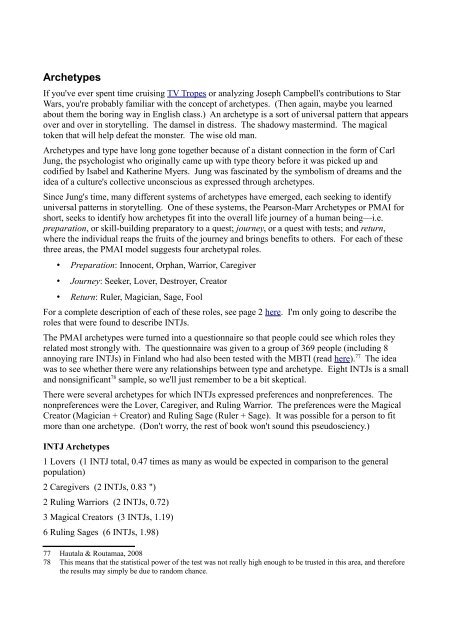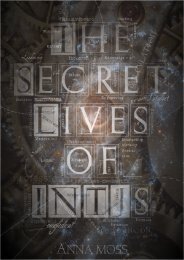You also want an ePaper? Increase the reach of your titles
YUMPU automatically turns print PDFs into web optimized ePapers that Google loves.
Archetypes<br />
If you've ever spent time cruising TV Tropes or analyzing Joseph Campbell's contributions to Star<br />
Wars, you're probably familiar with the concept of archetypes. (Then again, maybe you learned<br />
about them the boring way in English class.) An archetype is a sort of universal pattern that appears<br />
over and over in storytelling. The damsel in distress. The shadowy mastermind. The magical<br />
token that will help defeat the monster. The wise old man.<br />
Archetypes and type have long gone together because of a distant connection in the form of Carl<br />
Jung, the psychologist who originally came up with type theory before it was picked up and<br />
codified by Isabel and Katherine Myers. Jung was fascinated by the symbolism of dreams and the<br />
idea of a culture's collective unconscious as expressed through archetypes.<br />
Since Jung's time, many different systems of archetypes have emerged, each seeking to identify<br />
universal patterns in storytelling. One of these systems, the Pearson-Marr Archetypes or PMAI for<br />
short, seeks to identify how archetypes fit into the overall life journey of a human being—i.e.<br />
preparation, or skill-building preparatory to a quest; journey, or a quest with tests; and return,<br />
where the individual reaps the fruits of the journey and brings benefits to others. For each of these<br />
three areas, the PMAI model suggests four archetypal roles.<br />
• Preparation: Innocent, Orphan, Warrior, Caregiver<br />
• Journey: Seeker, Lover, Destroyer, Creator<br />
• Return: Ruler, Magician, Sage, Fool<br />
For a complete description of each of these roles, see page 2 here. I'm only going to describe the<br />
roles that were found to describe INTJs.<br />
The PMAI archetypes were turned into a questionnaire so that people could see which roles they<br />
related most strongly with. The questionnaire was given to a group of 369 people (including 8<br />
annoying rare INTJs) in Finland who had also been tested with the MBTI (read here). 77 The idea<br />
was to see whether there were any relationships between type and archetype. Eight INTJs is a small<br />
and nonsignificant 78 sample, so we'll just remember to be a bit skeptical.<br />
There were several archetypes for which INTJs expressed preferences and nonpreferences. The<br />
nonpreferences were the Lover, Caregiver, and Ruling Warrior. The preferences were the Magical<br />
Creator (Magician + Creator) and Ruling Sage (Ruler + Sage). It was possible for a person to fit<br />
more than one archetype. (Don't worry, the rest of book won't sound this pseudosciency.)<br />
INTJ Archetypes<br />
1 Lovers (1 INTJ total, 0.47 times as many as would be expected in comparison to the general<br />
population)<br />
2 Caregivers (2 INTJs, 0.83 ")<br />
2 Ruling Warriors (2 INTJs, 0.72)<br />
3 Magical Creators (3 INTJs, 1.19)<br />
6 Ruling Sages (6 INTJs, 1.98)<br />
77 Hautala & Routamaa, 2008<br />
78 This means that the statistical power of the test was not really high enough to be trusted in this area, and therefore<br />
the results may simply be due to random chance.




